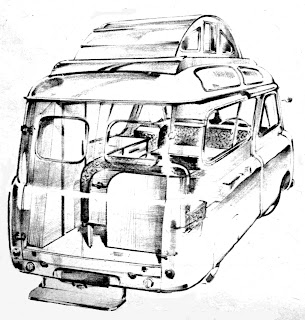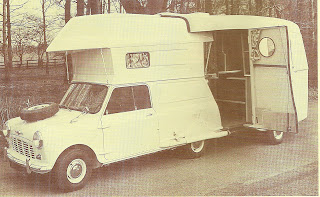Overview
The Bedford name is one that is synonymous with
quality, robust commercial vehicles. First introduced in 1931, Bedford was the brand name
given to Vauxhall’s commercial division, and the name of the vehicle marque was
derived from the County in which these vehicles were constructed, Bedfordshire, England. In a twenty year period
from its inception, Bedford
went from strength to strength, attaining excellent sales and an enviable
reputation for their range of commercial vehicles. During the years of WW11, Bedford vehicles were in
demand by the military, and the formidable Churchill tanks were also built at
the factory for use by the British Army.

The year 1952 is the significant
milestone in Bedford
history, certainly in terms of British-built camper vans. The year 1952, heralded the introduction of the Bedford
CA range of light vans, a vehicle
which was to become such a familiar sight in Britain over the ensuing sixteen
years. During that time the external design of the CA changed very little,
apart from cosmetic changes to the windscreen and wheel sizes, and was seen in
every guise from basic delivery van, to pickup and mobile shop to minibus. But
despite the vehicle’s success as an everyday utility base, the Bedford CA
will be forever associated with Martin Walter Ltd and its Dormobile Caravan
conversion, a model which introduced thousands of UK residents to the joys of
motorcaravanning.

By 1969 the CA range had become somewhat dated and Vauxhall
Motors released their all-new model, the CF range. Whereas the previous CA vans
had only really been utilised by Martin Walter Ltd for conversion to camper
vans, the new CF was far more appealing to the various conversion outfits due
to its increased dimensions and up rated mechanical components. Within its
first year of production more camper van models had been introduced using the
CF chassis than all those released in the seventeen year production of the CA.
Year by year more CF-based camper vans were unveiled, and as time progressed
the CF was upgraded and modified by Vauxhall Motors, making it more and more
appealing to both new and established motorcaravanners. In addition to the
success that the CF was enjoying in the UK, it was also proving to be a
very popular camper van base in many European countries.

During its eighteen year production
run, the CF light commercial range underwent several design changes, and
full-time production came to an end in 1987.
Between 1969 and 1987 the CF was constantly in the top five of the
favoured base vehicles used for conversion to camper van and motorhome by the
leisure industry. It is therefore not surprising that due to the numbers
converted, and the fact that it remained in production until 1987, that so many
Bedford CF-based camper vans have survived to this day.

Although 1987 did see the demise of the
once-great Bedford
marque in its familiar guise as a market leader, it was not quite the end of Bedford’s involvement with
the motorcaravan industry. The Vauxhall/Bedford Midi range was unveiled in the
mid-80s, although it was not a great commercial success, and was certainly not
held in the same regard as the previous CA and CF ranges. Despite a handful of
conversion companies using the Midi as a
camper van base, it failed to capture the imagination of the motorcaravan
buyers and only the Auto-Sleeper Midi, Devon
models and Midi-Home by Autohomes were worthy conversions of note.
.jpg)

By 1986 there had been a
re-organisation of the Bedford
marque, and a joint venture with Isuzu lead to the formation of ‘IBC Vehicles’.
In 1986 the Bedford Rascal was introduced, which in effect was a restyled
Suzuki Suepercarry, and fitted with the diminutive 970cc petrol engine. Whereas
the larger Midi van failed to attract the
attention of the major motorcaravan converters, the Rascal on the other hand
was used to great effect by the giant Autohomes concern in Dorset.
This company used the Rascal pickup version as a base for a micro-coachbuilt
camper, the Bedford Bambi. Through the remainder of the 80s, the little Bambi
really did become a great sales success winning several prizes within the
leisure industry. British caravan
builders Elddis also utilised the Rascal pickup, and entered the micro-camper
sector with their own Elddis Nipper. One would not have thought that the little
Bedford Rascal offered dimensions of adequate proportions in its basic panel
van format, but motorcaravan converters Danbury
released their tiny Danbury Renegade with its miniature rising roof and
diminutive interior fitments.


The demise of the Rascal range in the
early 1990s brought to a close several decades of Bedford use within the camper van/motorhome
market, much to the chagrin of the marques dedicated followers. In 1998 GM and
Isuzu ended their joint building venture, and from that moment the factory
operated as ‘GMM Luton’ That famous Griffin badge which adorned so many Bedford
vehicles could be seen once again on the bonnet (hood) of such light commercial
models as the Vauxhall Vivaro and Vauxhall Movano, though sadly only a handful
of bespoke converters have used these vans for conversion to camper vans.
Despite the loss of the Bedford
name/brand, it is a marque which will live long in the memory of commercial
vehicles enthusiasts around the world for many years to come.
If you would like to learn more about all of the various motorhomes and campervans built on the various Vauxhall-Bedford bases vehicles, then grab a copy of my hardback book, Bedford Camper Vans & Motorhomes', published by The Crowood Press.





.jpg)








Comments
Post a Comment